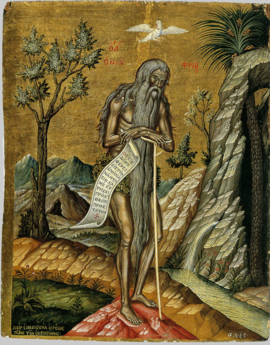| Saint Onuphrius | |
|---|---|
| Greek: Ὀνούφριος, Italian: Sant'Onofrio | |
 | |
| Artist | Emmanuel Tzanes |
| Year | 1662 |
| Medium | tempera on wood |
| Movement | Heptanese School |
| Subject | Saint Onuphrius |
| Dimensions | 31.4 cm × 24.8 cm (12.4 in × 9.8 in) |
| Location | Benaki Museum, Athens, Greece |
| Owner | The Rena Andreadis Icon Collection |
Saint Onuphrius is a tempera painting created in 1662 by Emmanuel Tzanes. Tzanes is one of the most important Greek painters of the 17th century. He was active in Crete, Corfu, and Venice, Italy. Both of his brothers were painters. He has a massive art catalog attributed to him. According to the Hellenic Institute over one hundred thirty of his works survived. He belongs to the Late Cretan School and Heptanese School of painting. He was part of the movement that introduced Flemish Engravings into the Greek world.[1][2]
Saint Onuphrius lived in seclusion in the desert of Upper Egypt. He was from Ethiopia. The name Onuphrius is a Hellenized version of the Coptic name Unnufer from the Egyptian word wnn-nfr meaning the perfect one.[3] He was a monk near Thebes. He studied law and philosophy before becoming a monk. He eventually left the monastery and lived in the desert for over sixty years. The only visitor he had to his monastic cell was an angel who delivered sacred bread every night. He also ate dates from desert palm trees. During his final days on earth, he was visited by a man named Paphnutius.[4]
When Paphnutius first saw him he was a scary wild figure covered with hair and wearing a loincloth of leaves. He frightened Paphnutius. He ran away from the scary homeless-looking man. The figure cried out: “Come down to me, man of God, for I am a man also, dwelling in the desert for the love of God.” Paphnutius followed the wild-looking half-naked man. He told him that he was a hermit living in isolation for over seventy years for God. He endured extreme discomforts such as hunger and thirst. An angel brought him to this place. Paphnutius stayed with him for the night. Bread and water miraculously appeared outside of the hermit's cell. Paphnutius recorded the story and his story. Onuphrius became a saint. He is venerated as Saint Onuphrius.[4]
Countless artists have depicted the subject matter namely Greek, Spanish and Italian painters. An early depiction of the monk can be found in the Greek Monastery of Varlaam. Notable works were completed there by Frangos Katelanos. Different versions were also completed by Francisco Collantes and his contemporary Jusepe de Ribera. Another exceptional depiction similar to Tzane’s work was Lorenzo Lotto’s masterpiece. Onuphrius is typically depicted with wild hair, in a leafy perizoma or loincloth as depicted in his story. The masterpiece is part of the collection of Rena Andreadis in Athens Greece. The collection is frequently exhibited at the Benaki Museum.[5]
- ^ Hatzidakis & Drakopoulou 1997, pp. 408–423.
- ^ Eugenia Drakopoulou (June 16, 2022). "Tzanes Emmanouil". Institute for Neohellenic Research. Archived from the original on September 23, 2015. Retrieved June 16, 2022.
- ^ Gardiner, Alan H. (1936). "The Egyptian Origin of Some English Personal Names". Journal of the American Oriental Society. 56 (2): 189–97. doi:10.2307/594666. ISSN 0003-0279. JSTOR 594666 – via JSTOR.
- ^ a b Butler, p.94.
- ^ Drandaki 2002, pp. 124–127.
© MMXXIII Rich X Search. We shall prevail. All rights reserved. Rich X Search
